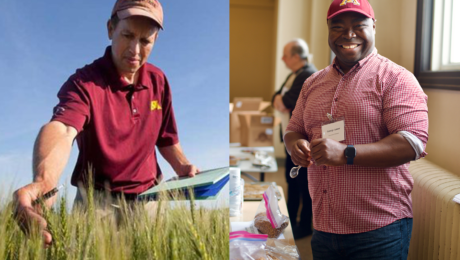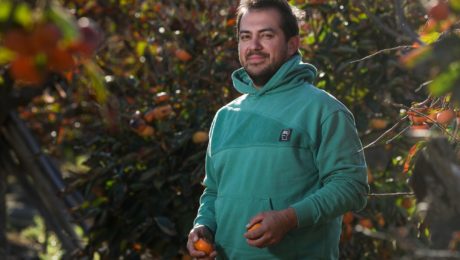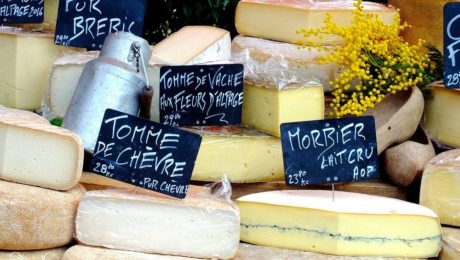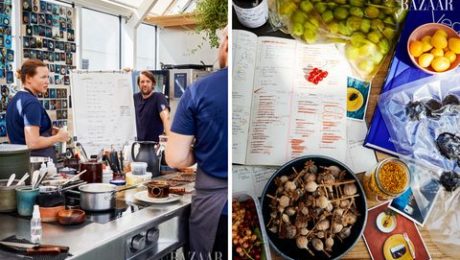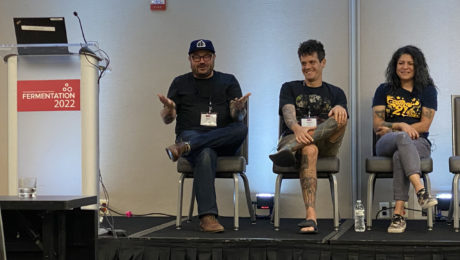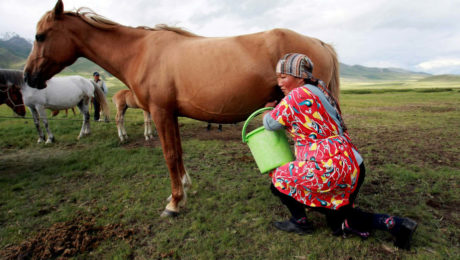Better Bread: Study Proves Sourdough Wins
Plenty of anecdotal evidence lauds sourdough as the healthier bread alternative for those with wheat or gluten intolerance, but there is little research providing data on the topic. Now new research proves the longer a sourdough ferments, the better the bread.
Sourdough is a fermented bread fortified with dietary fibers, increased mineral bioavailability, lower glycemic index and improved protein digestibility compared to its unfermented counterparts. And, as more people shun traditional bread because of a wheat or gluten intolerance, sourdough is increasing in popularity.
Researchers at the University of Minnesota are studying the effects of dough fermentation and wheat varieties to create a bread that’s easier to digest. They found the longer fermentation time makes a more digestible bread. The results, published in November in the Journal of Cereal Science, found a 12 hour ferment versus a four hour ferment dramatically reduces the short-chain carbohydrates that aren’t absorbed properly in the gut.
“Wheat sensitivity seems to be getting worse,” says James Anderson (pictured, left), professor and wheat breeder at the University of Minnesota and one of the study authors. “The motivation for me as a wheat breeder to get involved in this research is the wheat sensitivity issue.”
Those short-chain carbs – FODMAPs (fermentable oligosaccharides, disaccharides, monosaccharides and polyols) and ATIs (amylase/trypsin-inhibitors) – are what causes digestive problems in some people.
“There is evidence to document that sourdough processing or fermentation in general is able to reduce these FODMAPs and ATIs,” said George Annor (pictured, right), a professor of cereal chemistry and technology at the University of Minnesota and another of the study’s authors.
While fermentation time makes a difference in digestibility of sourdough, so do wheat varieties. Ancient grains such as Einkorn and Emmer performed well, same with the modern Linkert variety.
Though the study proves sourdough and other slow-rising breads can help those who are sensitive to wheat, the modern baking industry is dominated by sped up processing techniques. Like most commercial breads, frozen pizza crust and other convenience foods. Annor says he wants “them to keep those processes as much as they can,” but using a better wheat variety will aid digestibility.
“There’s more that we don’t know about fermentation than we do know, and it’s a wonderfully complex world,” says Brian LaPlante, a fellow Minnesotan and owner of Back When Foods.
LaPlante and his wife began making their own sourdough with ancient grains from his brother’s farm when LaPlante’s son began experiencing digestive problems. By incorporating sourdough and other fermented foods into his diet, his son’s health dramatically improved. LaPlante started his business Back When Foods that develops slow food with less processing – and hooked up with Anderson and Annor to help with their research. LaPlante provided the dough samples of varying ferment times that the UofM analyzed for their study.
“When you have fermented food in your diet, it has a profound impact on your microbiome,” he adds. “And I think that will be the trend, is food will become your medicine again.”
Ugly Fruit into Delicious Kombucha
A new Los Angeles-based kombucha brand has a unique approach to their fermented tea. Sunset Cultures owner and chef Balo Orozco (pictured) uses the unsold or “ugly” fruits and vegetables from local farms into “some of L.A.’s most creative kombuchas, hot sauces and condiments.”
Staying true to his goal of curbing food waste and helping local farmers is certainly not easy. Orozco spends much of his days driving across the state to pick up boxes or pallets of produce that would otherwise be thrown away or composted. Another challenge: the kombucha flavors and condiment offerings change with the amount and type of surplus product Orozco receives from farmers. (Sunset Cultures does consistently sell four core kombucha flavors).
Orozco’s roots are in the restaurant industry. As a chef, he was alarmed at the amount of kitchen waste restaurants would throw away. His specialty soon switched to reusing kitchen scraps and fermenting house-produced condiments. After the last restaurant he worked at folded due to the pandemic, he began working on Sunset Cultures.
Sunset Cultures products are always changing and adapting based on available products. In the last six months, Sunset Cultures began making jam, a solution to their own wasted byproduct from the lightly boiled strawberries used in their kombucha.
Sunset Cultures products are currently sold in 40 retail shops and online, with plans to expand to other cities in 2023.
Read more (Los Angeles Times)
- Published in Food & Flavor
Microbes in Cheese
Do you love a mild mozzarella, a salty Parmesan or a funky brie? Thank microbes.
Though the thousands of varieties of the world’s cheeses all begin as a white lump of curd, the diversity is astounding. From the flavor to the color to the texture, cheese goes from “uniform blandness to this cornucopia” thanks to bacteria, yeasts and molds. An article in Smithsonian Magazine – titled The Science Behind Your Cheese – shares the details.
“More than 100 different microbial species can easily be found in a single cheese type,” says Baltasar Mayo, a senior researcher at the Dairy Research Institute of Asturias in Spain.
Scientists have only recently begun to study the microbial nature of cheese. To find out the bacteria and cheese present, scientists extract DNA from the cheese, then match it to genes in the database.
“The way we do that is sort of like microbial CSI, you know, when they go out to a crime scene investigation, but in this case we are looking at what microbes are there,” says Ben Wolfe, a microbial ecologist at Tufts University.
Though cheesemakers often add starter cultures of beneficial bacteria to fresh curds to transform it into a delicious cheese, Wolfe’s team found the microbiomes of the cheese “showed only a passing resemblance to those cultures. Often, more than half of the bacteria present were microbial ‘strangers’ that had not been in the starter culture,” continues the article.
Those “strangers” dumbfounded researchers. Microbes like Brachybacterium found in Gruyère are more commonly found in soil, seawater and chicken litter. Or the Halomonas most commonly found in salt ponds and marine environments. Or, Brevibacterium linens found in damp areas of skin, such as between the toes. Those bacteria come from the environment of the cheesemaking facilities. The microbes come from the cow, goat or sheep, the bacteria in the farm’s stable, the skin bacteria from the hand of the milker, the microbes in the dairy storage tank and/or the sea salt in the brine used to wash down the cheese. Hundreds of bacteria have been detected in long-ripened cheeses.
“Furthermore, by repeatedly testing, scientists have observed that there can be a sequence of microbial settlements whose rise and fall can rival that of empires,” continues the article.
Modern cheesemaking is, sadly, more controlled, meaning modern cheese isn’t as flavorful. Cheesemaking has “become tamer over time,” cleaner and more sterilized, filtered, pasteurized, machine operated.
“Many of our cheddars, provolones and Camemberts, once wildly proliferating microbial meadows, have become more like manicured lawns. And because every microbe contributes its own signature mix of chemical compounds to a cheese, less diversity also means less flavor — a big loss.”
Read more (Smithsonian Magazine)
- Published in Food & Flavor, Science
Organization Necessary for Creativity at Noma
Beautiful photos of the “farm to table mecca” Noma graced the pages of this month’s Harper’s Bazaar, with an accompanying article interviewing chef-owner Rene Redezepi and R&D head Mette Brink Søberg. The Nordic restaurant has come to redefine modern fine dining as using local and seasonal ingredients.
When Noma started, Redzepi says the challenge was how to serve Nordic food year-round, even in the harsh climate of Copenhagen.
“I thought to myself, why are we trying to serve a tasting menu with a little bit of everything as opposed to what’s really good when it’s available?” Redzepi says.
Noma’s tasting menu is divided into three cycles – plant-based in the summer, wild game and foraged mushrooms in fall and local fishermen’s hal in the winter. Noma’s test kitchen is in a greenhouse next to the garden, “we are very connected to the seasons and can pick flowers and leaves to use on the menu right at our doorstep,” Søberg says.
Redzepi says necessary to their creativity is organization. They make a list of ingredients and techniques they’d like to employ, make deadlines and use pictures as a frame of reference. “We keep meticulous records of finished dishes,” he says.
“In the beginning of the creative process, it is important to allow ourselves to spend time working on those ideas that might at first glance seem impossible or ridiculous, because even if they might not end up on the menu, they could lead to something that we would have never come across if we hadn’t sacrificed the time,” Søberg adds. “Often the most innovative and original elements on the menu have many weeks and sometimes months of work behind them.
Read more (Harper’s Bazaar)
- Published in Food & Flavor
Bean-free Chocolate & Coffee
The front page of the Financial Times featured a new wave of alternative foods: chocolate and coffee, but without the beans.
Cultivating both cocoa beans for chocolate and coffee cherries for coffee at such a high rate for global consumption is damaging to the environment. It’s linked to deforestation. The working conditions for many of the farmers are also deplorable, with child and slave labor and poor wages. Now multiple startups are trying to make a market for bean-free products.
“You realise that a lot of our favourite foods, whether it’s beef burgers or a cult of coffee or a chocolate bar, there’s so much damage,” said Johnny Drain, chief technology officer of WNWN Food Labs, a London-based maker of cocoa-free chocolate. “Not just to the climate but to the people, typically in developing countries who are producing those products for us.”
Drain is a fermentation expert who formerly worked with restaurants to make unique flavor profiles using fermentation. He’s founded WNWN with Ahrum Pak, a former financier now working in the foodtech space with Drain (both pictured). Their chocolate is made from fermented barley and carob.
More startups are, too, trying to be a solution to an unhealthy chocolate and coffee industry. In Munich, Planet A developed a cocoa-free chocolate which has chief ingredients of fermented oats and sugar beet. They call it “Nocoa.” In the U.S., Voyage Foods and California Culture make chocolate from lab-grown cocoa.
Bean-free coffee, meanwhile, has been created by two U.S. startups – Atomo in Seattle uses date seeds, chicory root, grape skin and green tea to create a canned cold brew coffee. Compound Foods in San Francisco. The latter is recreating coffee using synthetic biology and fermentation.
“We want to give consumers a choice,” said Andy Kleitsch, co-founder of Atomo, who added that although they had been worried that “the coffee industry would hate us or that the baristas might hate us, the reception has been positive”.
Many of these entrepreneurs note alt products are not the only solution to an environmentally-damaging food industry. Drain adds: “It’s just one additional way of trying to change an industry that is built on inequity and slave labour.”
Read more (Financial Times)
- Published in Business, Food & Flavor
Upcycling & Zero Waste
Fermentation is a powerful culinary tool for upcycling.
During the Upcycling and Zero Waste session at FERMENTATION 2022, six fermentationists with diverse backgrounds in the industry shared how they’re using fermentation to reduce food waste.
“As a chef, we are constantly chasing these depths of flavors and things that you can’t get in regular cooking applications or techniques. Fermentation opened up a whole new world of flavor,” says Jessica Alonzo, a fermentation specialist and owner of small batch ferments company Native Ferments in Texas. “We were looking to enhance diner’s experience and fermentation did that.”
The panelists from all over the world included: Alonzo, Jeremy Kean (chef/owner of Brassica Kitchen), Mac Krol (CEO/founder of Mac Ferments), Richard Preiss (cofounder and brewing scientist at Escarpment Labs), Michelle Ruiz (CEO/co-founder of Hyfé Foods) and Ismail Samad (founder of Loiter and Wake Robin Foods).
Aiding farmers
Alonzo consults with area restaurants to build unique larders. She helped create the fermentation and whole food utilization program at Petra and the Beast as the former sous chef. Fermenting the restaurant byproducts helped the restaurant eliminate food scraps, cut down on food cost and partner with farmers.
Up to 40% of food grown in America is thrown away, according to the U.S. Department of Agriculture.
“I got into zero waste and upcycling through relationships with farmers, seeing how much was wasted at the farm level,” says Samad, who also co-founded and was executive chef at The Gleanery in Vermont. “The Gleanery existed for the last 12 years to provide a very clear safety net for farmers not selling their stuff at the farmers market.
Samad admits he didn’t know much about fermentation when he first started, “We just knew we didn’t want to keep wasting food.” By fermenting the kitchen scraps, “we’re making sacrifices that big food won’t do.”
Exploring Science
At a scientific level, Preiss at Escarpment is looking at upcycling “through a microbiologist lens.” Preiss said he began upcycling when he realized the current food system is unsustainable in a linear economy.
“There’s a lot of opportunity for creating circular food economies to not only reduce waste but help every single stakeholder involved in this process make more money, pay people more, create jobs, be more profitable and ultimately stay open as part of the sustainability discussion,” he says.
Restaurants are often leading upcycling and fermentation conversations – “many people know about fermentation because of restaurants.” But Preiss says the craft beer industry is becoming a leader in the upcycling movement because, today, they’re in many neighborhoods. “They have a really cool platform to communicate new ideas around food innovation.”
Escarpment is exploring interesting ways to use spent grains from beer. Currently, they’ve created a way to make seasonings. Brewers use those seasonings in their menu dishes, a novelty that gets customers excited about pairing a beer with a dish seasoned with that craft brew’s spent grain.
“There’s a lot of opportunity in that grain, there’s still a lot of nutritional quality,” Preiss says. “Through fermentation, we unlock new possibilities.”
Hyfé Foods is also utilizing waste. They’re taking the discarded sugar water (typically used in beverage production) and, through fermentation, repurposing it in mycelium flour. Mycelium is a type of mushroom. Hyfé’s proprietary biotechnology makes a protein-rich, low carb mycelium flour in a carbon-neutral, affordable process.
“Often when a manufacturer makes a product, the lifecycle being considered ends at the door. We’re often not measuring the greenhouse gas emission impact, the wasted sugar water – that goes down the drain,” says Ruiz. Food manufacturers pay a hefty fee to get rid of waste water. “We’re really excited about the position that upcycling puts us in, not only from a cost standpoint but also we’re creating a really nutritious, low cost food.”
Upcycling Barriers
Upcycling is not without its challenges.
Kroll at Mac Ferments specializes in koji. He recently created shoyu made with used coffee grounds, koji, water and salt – an excellent choice, he says, for a restaurant that likely throws out pounds of coffee grounds at the end of the night.
“It is obviously nice to create added volume from leftovers, it tightens the whole supply chain,” Kroll says. “But also there are risks of potentially overproducing just to create extra waste. You have to be careful what you’re doing because you’re dealing with enzymes – and we don’t see microbes.”
Fermentation, he says, should be utilized for quality, not quantity.
“If every dish has something fermented, a regular customer might come home starving,” Kroll adds.
Preiss sees collaboration as a major challenge because creating a circular, upcycled system involves multiple stakeholders sharing their waste products.
“Upcycling can’t be done in a silo, you need collaboration, and getting people that have the different pieces of the puzzle together to make it happen is the biggest challenge,” he says.
Samad, meanwhile, says scaling is a hurdle. “There are opportunities for investments around upcycling, but there’s a ceiling where this culture or ethos can be sustained.”
Educating customers, too, can be tricky. The public consuming the product or dish needs to understand what is upcycled. Servers, as the mouthpiece to diners, must taste and know a dish to communicate its elements. Chefs must detail to servers where ingredients were sourced, how long the food was aged and what was cross utilized, Alonzo says.
Panelists said the public is excited about the new taste experiences with upcycled food – but they’re also more curious about the science behind it.
“Folks come into Brassica for that fermentation program and are so interested and hungry for that knowledge from the science community,” Kean says. “And then theres folks that just want to eat and say ‘What the fuck was that?’ I think it’s a mixture between the two.”
“The education around all this stuff is growing,” he adds. “I see the culinary world and science world getting closer and closer together and I think that’s the right direction.”
- Published in Food & Flavor, Science
Fermented Flavor Development in Restaurants
In the last decade, fermentation has taken center stage at fine dining restaurants. How do owners and chefs develop and maintain a fermentation program for their kitchen?
An all-star team of U.S. chef-owners at FERMENTATION 2022 shared their successes and failures in developing fermentation-focused kitchens. Speakers included: Sean Brock of Audrey Restaurant in Nashville, Jeremy Kean of Brassica Kitchen in Boston and Misti Norris of Petra & the Beast in Dallas. Jori Jayne Emde, chef, educator and owner of Corner Office in Taos, New Mexico, moderated the discussion.
The chefs all focus on whole food utilization, aiming to eliminate food waste in flavor-packed dishes. Fermentation is key. Food scraps that would otherwise be thrown out – stems from produce, coffee grounds or animal bits – are fermented and reinvented in flavorful, unique dishes.
“By reusing the product in different manipulations over and over again, this type of program can really develop branding potential over time,” Emde says. “The process of bringing several lives to one product puts one’s fingerprint on the cuisine, so the restaurant expresses its own terroir.”
In-House Fermentation
Core to developing a restaurant fermentation program is assigning someone to oversee the process. Who will track the start dates, monitor pH levels and control filtration?
Emde, who formerly ran Fish & Game in New York’s Hudson Valley, quickly learned at the restaurant “you can’t just have a multitude of chefs handling it…ferments are alive and require being nurtured and cared for.”
Brock agrees, noting some restaurants have their chef de cuisine or sous-chef head up fermentation efforts. “But the reality is they have so much to do already.”
“It’s critical to have someone dedicated to the program,” Brock says. “When you’re having to build such a renegade operation, the biggest challenges are keeping up with inventory and monitoring each ferment.”
Audrey hired a fermentation specialist in 2014, Elliot Silber. He has a chemistry degree and “understands fermentation at a completely different level,” Brock says.
“I still can’t believe we have someone in charge of fermentation,” he adds. “Now, we put fewer things on the plate with a bigger impact. I get to finally produce food I would consider minimalist.”
Brassica Kitchen takes a different approach to their fermentation program – a food map.
“We’ve been running fermentation forward cuisine for about 10 years and, in that 10 years, we’ve gone through a lot failure and chaos and really kind of developing things as we go, to changing the menu everyday to coming in long before service to staying long after to doing inventory and plug and play with them. We hit a wall,” Kean says. “We’ve found ourselves looking at over 100 misos and going ‘What the fuck do we do with this?’”
The kitchen’s food map is a shared document where the chefs outline how to utilize every byproduct. It’s been Brassica’s most effective menu-planning solution. “This food map has solved a lot of the problems and created a box of creativity we can really thrive in,” Kean says.
Health Department Woes
When Brock launched his first fermentation program at Charleston’s Husk restaurant in 2010, “ironically our biggest challenge was the health department,” Brock said. “They would make us throw food away.”
Health department officials – many who had no idea what fermentation was or its inherent safety – would immediately issue violations for any food sitting on a counter at room temperature, a normal process for fermenting foods or beverages. Husk maintained a makeshift lab on the roof of the restaurant hidden from officials, and staff had a code word for when the health department would come to the restaurant.
Norris recalled instances where inspectors would pour bleach on their fermented food products or throw their meat in the trash.
“It’s hard because we’ve taken the time to learn and be knowledgeable about how to keep these foods safe. And then someone comes in who is supposed to be keeping people safe but has no knowledge of food and we’re trying to make food healthier and keep it more dynamic and sustainable,” Norris says. “It’s frustrating when you put so much of yourself and your philogosphy into the food.”
Audience Acceptance
Today – as fermentation is featured regularly in food, health and science news – diners are eager to eat unique, fermented dishes. This hasn’t always been the case. Even today,diners need to trust a restaurant before they will buy dishes experimenting with fermentation. Norris notes, when Petra and the Beast first opened, fermentation was not a food trend in Texas. Residents had not grown up with a food culture of eating and preserving wild food.
“It definitely did not happen overnight,” she says. “It took a lot of educating and reassuring people that these things are delicious and they are a little uncommon, a little different. It’s something that took time and effort to understand what we were doing with full utilization and sustainability.”
Kean, too, said it took time at Brassica.
“We’d be using all these (fermented) products and I wouldn’t even mention it on the menus,” he said. “The trust was built over all these years and until we could really start speaking on it.”
Eliminating food waste was mentioned as fermentation’s gateway of acceptance for diners.
Food Waste into Food
Brock says the goal at Audrey is to find 10 uses for every seasonal, region-specific ingredient. For example, last year they received candy roaster squash from a local farm and served it in different forms in dishes throughout the fall season. But they also fermented it and will be serving it again this year.
“We don’t create dishes and then get the ingredients,” Brock says, “the ingredient fuels the dish.”
The kitchen at Audrey is full of glass-encased ferments, each organized by parts of the tongue.
Brassica has found success in utilizing food waste by creating delicious dishes that are “black holes for the extra stuff” Kean says. For example, they serve a fried rice dish using sticky rice from the day before with fermented vegetables. The dish is popular, low cost and “encourages little things that can be vehicles in a dish.”
“It’s been inspiring over the years to find a use for the byproducts, then the byproducts become so important that you have to then buy the byproduct,” he says. “It’s happened to us over and over again.”
Petra and the Beast focuses on whole animal utilization. By being sustainable and “hyper-seasonal,” Norris says, Petra is “creating food with the most depth, creating food that’s not just one note.”
“I ask myself and the team ‘Well, what should we do with it? Is there a better use for it? Is there a sour brine or can we make a salt out of it and use it on that same vegetable next season?’” Norris says. “If you really truly understand why a flavor profile is developing in a certain way, you look at everything else differently.”
- Published in Food & Flavor
Endangered Fermented Foods
Through selective breeding and domestication of plants and livestock, the world’s food system has lost diversity to an alarming degree. Crops are monocultures and animals are single species. Journalist and author Dan Saladino argues it’s vital to the health of humanity and our planet to save these traditional foods.
“There’s an incredible amount of homogenization taking place in the last century, which has resulted in a huge amount of concentration of power in the food system but also a decline in the amount of biodiversity,” says Saladino, author of Eating to Extinction. “That agricultural and biological diversity is disappearing and it’s taken us thousands, millions of years for plant, animal evolution to get to this point.”
Saladino was a keynote speaker at The Fermentation Association’s conference FERMENTATION 2022, his first in-person talk in the United States since his book was released in February. A journalist with the BBC, Saladino was also an active participant in the event, attending multiple days’ worth of educational sessions. He called the conference “mind expanding.”
“I thought I knew about fermentation, when in fact I know very little,” Saladino said to the crowd in his keynote. “We’ve been bemused by the media reports that fermentation is a fad or fashion. What we know is that the modern food system in the last 150 years is the fad. It’s barely a blip in the context of our evolution as species, and it’s the way we’ve survived as a species over thousands of years.”
Eating to Extinction includes 40 stories of endangered foods and beverages, just touching on a fraction of what is happening around the world. To date, over 5,000 endangered items from 130 different countries have been cataloged by the Slow Food Foundation’s project the Ark of Taste.
During FERMENTATION 2022, Saladino centered his remarks around the endangered fermented foods he chronicled in his book – Salers cheese, skerpikjøt, oca, O-Higu soybeans, lambic beer, pu’erh tea, qvevri wine, perry and wild forest coffee. Here are some of the highlights of his presentation.
Salers cheese (Augergne, Central France)
Fermentation was a survival strategy for many early humans, a fact especially evident in the origins of cheesemaking. In areas like Salers in central France, villagers live in inhospitable mountain areas where it’s difficult to access food. In the spring each year, cheesemakers travel up the mountains with their cattle and live like nomads for months.
“It’s extremely laborious, hard work,” Saladino says, noting there’s only a handful of Salers cheese producers left in France. He marvels at “the ingenuity of taking animals up and out to pasture in places where the energy from the sun and from the soil is creating pastures with grasses with wildflowers and herbs and so on.”
Unlike with modern cheese, no starter cultures are used to make Salers cheese. The microbial activity is provided by the environment – the pasture, the animals and even the leftover lactic acid bacteria in the milk barrels. Because of diversity, the taste is rarely consistent, ranging season to season from mild to aggressive.
“The idea of cheesemaking is a way humans expand and explore these new territories assisted by the crucial characters in this: the microbes,” he adds. “It can be argued that cheese is one of most beautiful ways to capture the landscape of food – the microbial activity in grasses, the interaction of breeds of animals that are adapted to the landscape. It’s creating something unique to that place.”
Skerpikjøt (Faroe Islands)
Skerpikjøt “is a powerful illustration to our relationship with animals, with meat eating,” Saladino says. It is fermented mutton and unique to Denmark’s Faroe Islands. Today’s farmers selectively breed their sheep for ideal wool production, then slaughter the lambs for meat. In the Faroes, “the idea of eating lamb was a relatively new concept.” Sheep are considered vital to the farm as long as they’re still producing wool and milk.
Once a sheep dies or is killed, the mutton carcass is air-dried and fermented in a shed for 9-18 months. The resulting product is “said to be anything between Parmesan and death. It certainly has got a challenging, funky fragrance,” Saldino says.
But it contrasts traditional and modern food practices. Skerpikjøt is meant to be consumed in small quantities, delicate slivers of animal proteins used as a garnish. Contemporary meat is served in large portions and meant to be consumed quickly.
Oca (Andes, Bolivia),
In the Andes – “one of the highest, coldest and toughest places on Earth to live” – humans have relied on wild plants like oca, a tuber. After oca is harvested, it’s taken to the Pelechuco River. Holes are dug on the riverbank, then filled with water, hay and muna (Andean mint). Sacks of oca are placed in the holes, weighted down by stones, and left to ferment for a month. This process is vital as it leaches out acid.
“Through processing, this becomes an amazing food,” Saladino says.
But cities are demanding certain types of potatoes, encouraging remote villagers to plant monocultures of potatoes which are prone to diseases. The farmers end up in debt, buying fertilizers and pesticides to grow potatoes.
“For thousands of years, oca and this fermentation technique and the process to make these hockey pucks of carbohydrates and energy kept them alive in that area,” Saladino says. “It’s a diversity that is fast disappearing from the Andes.”
O-Higu soybeans (Okinawa, Japan)
The modern food industry is threatening the O-Higu soybean, too. It was an ideal soybean species – fast-growing, so it can be harvested before the rainy season and the arrival of insects.
“But by the 20th century, the soy culture pretty much disappeared,” Saladino says.
With World War II came one of America’s biggest military bases to Japan. U.S. leaders dictated what food could be planted on the island. Okinawa was self-sufficient in local soy until American soy was introduced.
Lambic Beer (Belgium)
Saldino explained that, after a spring/summer harvest, Belgian farmers became brewers. They used their leftover wheat to create brews unique to the region.
But by the 1950s and 1960s, larger brewers began buying up the smaller ones. Anheuser-Busch InBev now produces one in four beers drunk around the world.
“There [is] story after story of these distinctive, unique, small breweries disappearing as they are bought up or absorbed into this growing, expanding empire of brewing,” Saladino says. “It’s probably one of the most striking cases of corporate consolidation of a drink and food product.”
Saladino stressed not all is lost. He shared stories of scientists, researchers and local people trying to save endangered foods, collecting seeds, restoring crops and combining traditional and modern-day practices to preserve the world’s rare foods.
“There have been so many fascinating stories of science and research discussed over the last few days at this conference, and I think the existence of The Fermentation Association is exciting because it is bringing together tradition, culture, science, culinary skills, all of these things we know food is,” Saladino added. “Food is economics, politics, geography, anthropology, nutrition. What I’m arguing is that these clues or glimpses into the past for these endangered foods, they’re not just some kind of a food museum or an online catalog. They are the solutions that can help us resolve some of the biggest food challenges we have.”
- Published in Food & Flavor
Can Science Improve Chocolate?
Just like wine and coffee, the flavors of chocolate come from the local terrain, climate and soil where the cacao bean is grown. Chocolates from various parts of the world all taste different. Can those tastes be replicated?
Scientists are trying to determine what produces those flavors and if they can reproduce them consistently. Irene Chetschik, professor in food chemistry at Zurich University of Applied Sciences, has developed “new technological processes that can impact cocoa flavor on a molecular level — to get the best out of each harvest and create consistent quality,” details an article in BBC.
Chetschik says: “Now there is more appreciation for the product – we know where the bean is coming from, which farm, which variety – we can experience a much wider flavor diversity.”
Cocoa beans traditionally are fermented where they are grown. Fermentation will affect quality – a poorly-fermented bean has little flavor; while an over-fermented bean can become too acidic.
Chetschik has developed a “moist incubation” fermenting technique where a lactic acid solution containing ethanol is applied to dried cocoa beans. It triggers the same fermentation reaction in the beans, “but is far easier to control,” she says. The final taste is sweet, rich and fruity.
Nottingham University is also working on a chocolate-enhancing project. They’re using a hand-held DNA sequencing device to analyze the cocoa bean microbes. “With improved understanding of what drives the taste of premium chocolate, fermentation can be manipulated for improved flavor.”
Read more (BBC)
- Published in Food & Flavor, Science
Would You Drink Fermented Horse Milk?
The country of Kyrgyzstan is hoping to attract tourists by highlighting traditional kumis – fermented mare’s milk. Locals drink and bathe in the liquid for health benefits. Promotional films romanticize a visit to the Asian country, highlighting how one can experience the nomadic Kyrgyz lifestyle by sleeping in a mountain yurt near herds of horses.
“We decided to try it after hearing about saamal (another word for mare’s milk) and kumis from our friends who had visited Kyrgyzstan,” says Ibrahim al-Sharif, a tourist from Mecca, Saudi Arabia, in a CNN Travel article. “I cannot even describe its taste. There is nothing in Saudi Arabia that I would compare with it.”
CNN notes “milking a mare is far trickier than milking a cow.” A person must be big enough to reach their arms around the horse’s thigh. A milking is not done year round but in mid-May and mid-July, traditionally ending when the Pleiades star cluster appears.
Read more (CNN)
- Published in Food & Flavor

